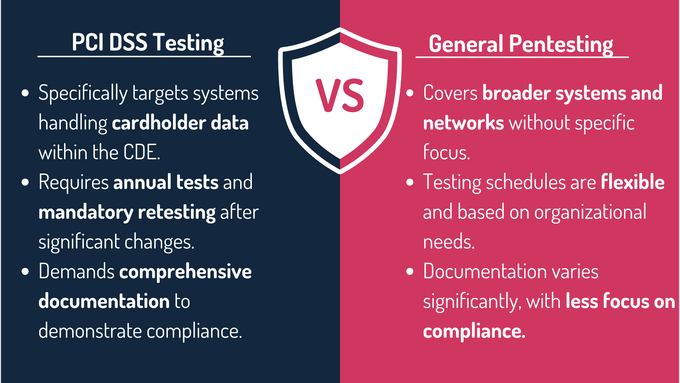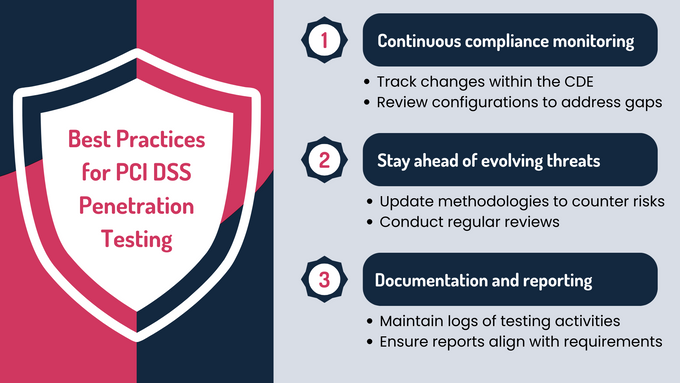Challenges of PCI DSS Penetration Testing: Best Practices & Strategies
PCI DSS focuses on compliance and protecting cardholder data, targeting the cardholder data environment and mandating detailed reporting. The challenges of PCI DSS penetration testing can be easily remediated.
Published April 5, 2025.

The Payment Card Industry Data Security Standard (PCI DSS) is a global framework established to safeguard cardholder data and maintain secure payment environments. Despite these core PCI security standards, data breaches remain a significant concern. In fact, in 2024 alone, cyberattacks using stolen or compromised credentials increased 71% year-over-year, according to IBM. This especially affects the financial sector, where cardholder data remains a prime target for attackers.
In simple terms, PCI DSS penetration testing helps identify and mitigate vulnerabilities in payment systems, ensuring compliance and reducing the risk of breaches. More than just compliance, different types of penetration testing simulate real-world attacks to uncover weaknesses, strengthen defenses, and build trust by safeguarding sensitive information.
» Take the first step towards PCI DSS compliance: Reach out to our experts
PCI DSS Penetration Testing vs. General Penetration Testing
In short, PCI compliance penetration testing focuses on the cardholder data environment (CDE) to ensure compliance, requiring annual tests and rigorous documentation to protect cardholder data. On the other hand, general penetration testing is broader and more flexible, targeting overall system security without specific compliance requirements.
| Aspect | PCI DSS Penetration Testing | General Penetration Testing |
|---|---|---|
| Scope | Requires a targeted approach, focusing exclusively on systems that store, process, or transmit cardholder data (CHD) and all connected systems within the Cardholder Data Environment (CDE) | Offers broader flexibility, allowing organizations to test any part of their network or applications without specific emphasis on payment processing systems |
| Frequency | Mandates annual penetration tests and testing after significant changes, such as infrastructure updates or new system implementations, ensuring PCI DSS penetration testing frequency is met | Does not adhere to standardized schedules. Testing frequency is determined by organizational policies and needs, ranging from periodic assessments to ad-hoc testing |
| Documentation | Requires comprehensive documentation, including detailed methodologies, findings, and remediation efforts, to demonstrate compliance with regulatory standards | Documentation standards are less stringent, varying widely depending on the organization’s goals and requirements |
| Objective | Ensures compliance with PCI DSS to protect cardholder data | Broader focus on overall system security |
» Explore the benefits of being PCI DSS compliant and stay up to date with key changes in PCI DSS 4.0
Common Challenges in PCI DSS Penetration Testing
1. Legacy Systems
Legacy systems often lack modern security features, leaving them more susceptible to vulnerabilities. These outdated systems can be challenging to patch or upgrade without disrupting critical business operations, making them a frequent weak point in compliance efforts.
2. Cloud Environments
The adoption of cloud environments introduces challenges due to complex hybrid architectures that blur the boundaries of the cardholder data environment (CDE). Additionally, the shared responsibility model between cloud providers and businesses can create ambiguities in security responsibilities, complicating the testing process.
» Relying on the cloud? Read more about its potential risks
3. Large and Diverse IT Infrastructures
Organizations with extensive, interconnected IT infrastructures face an increased attack surface. Identifying all components within the scope of PCI DSS pentest requirements can be time-intensive and prone to oversight, especially in dynamic environments with continuous changes.
4. Regulatory Overlap
Businesses subject to multiple compliance frameworks often face conflicting or overlapping requirements. Aligning PCI DSS penetration testing efforts with other regulations can be challenging, leading to inefficiencies and duplicated efforts in maintaining good compliance.
5. Human and Resource Constraints
PCI DSS-specific penetration testing requires skilled professionals, but the demand for expertise often strains organizational resources. Limited staff and budgets can make it difficult to conduct thorough and timely tests, delaying remediation efforts and increasing compliance risks.
3 Tips for Overcoming PCI DSS Penetration Testing Challenges
1. Resource Management
Allocating skilled professionals and leveraging automated tools can significantly optimize penetration testing processes. Automation reduces repetitive tasks, while expert oversight ensures the accurate identification of vulnerabilities. Partnering with cyberservice professionals can also help fill skill gaps and streamline testing efforts.
Here are practical tips to help streamline the process:
- Focus testing efforts: Prioritize high-value targets within the cardholder data environment (CDE) that present the greatest risk, while deferring lower-priority components for future assessments.
- Leverage existing security measures: Maximize the use of existing tools and frameworks, such as vulnerability scanners and monitoring systems, to reduce redundancy and resource strain.
- Use third-party support: Partner with experienced consultants or service providers to access specialized skills.
2. Remediation Efficiency
Addressing identified vulnerabilities quickly is critical to maintaining compliance and reducing risk. Establishing clear workflows for remediation and prioritizing high-risk findings ensures that vulnerabilities are resolved without delays. Moreover, utilizing vulnerability management platforms can improve tracking and communication across teams during the remediation process.
» Need more help? Follow our step-by-step guide to penetration testing
3. Minimizing Downtime
Testing in live environments requires careful planning to prevent disruptions to critical operations. Scheduling tests during off-peak hours and using staging environments for initial assessments can minimize the impact on business continuity. Collaboration between security and operations teams ensures smooth execution and reduces potential downtime during testing.
Best Practices to Align Penetration Testing With PCI DSS Compliance
1. Continuous Compliance Monitoring
Implementing continuous monitoring tools helps organizations track changes within the CDE. Regularly reviewing system configurations ensures all components meet PCI DSS standards, proactively addressing security gaps. This approach provides real-time visibility into security postures, enabling organizations to respond swiftly to potential risks.
2. Stay Ahead of Evolving Threats
The threat landscape is constantly changing, requiring businesses to update penetration testing methodologies. Regular threat intelligence reviews provide insight into emerging risks, helping organizations adapt their defenses to counter new attack vectors. By staying informed, businesses can proactively mitigate vulnerabilities before they are exploited.
» Feeling confused? Compare traditional compliance methods and automation platforms
3. Documentation and Reporting
Thorough documentation of testing activities is crucial for demonstrating PCI DSS compliance. Actionable reports help align remediation efforts with requirements while ensuring transparency with auditors and stakeholders. Clear and detailed records also enable efficient progress tracking and highlight areas for ongoing improvement.
Regularly updating testing methodologies and maintaining detailed documentation ensures PCI DSS compliance while addressing threats. Proactive monitoring tools can simplify compliance and enhance security posture.
» Learn how to fortify your PCI DSS security strategy for long-term protection
Streamline PCI DSS Penetration Testing With GRSee
We understand the complexities of PCI DSS penetration testing and are here to provide expert solutions. With a team of certified PCI DSS professionals, GRSee brings extensive experience in consulting and testing to help your organization meet compliance standards while enhancing overall security. Our tailored methodologies address the unique challenges of legacy systems and cloud infrastructures, ensuring critical vulnerabilities are identified and mitigated.
» Ready to get started? Contact us







